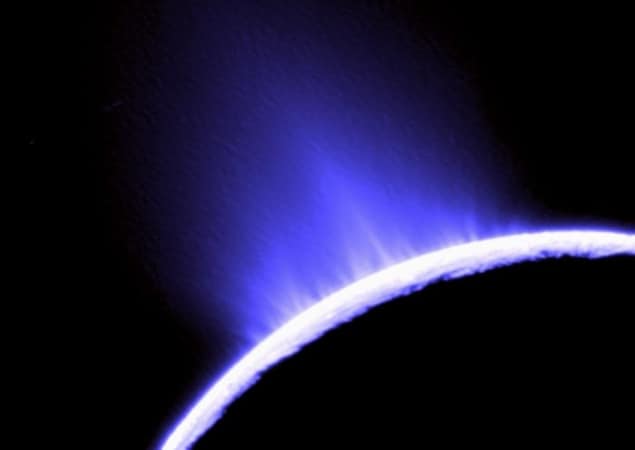
The water geysers of Enceladus spew the most material when the small moon ventures farthest from Saturn, planetary scientists in the US have found. This discovery confirms a prediction of a theory that says the geysers’ strength depends on Saturn’s tide.
Discovered by the German-born English astronomer William Herschel in 1789, eight years after he spotted the planet Uranus, Enceladus is the sixth largest of Saturn’s 62 known satellites. The small moon is 238,000 km from Saturn’s centre, about two-thirds of the distance from the Earth to the Moon. Because Saturn is so massive, though, its gravity forces Enceladus to circle it every 1.37 days.
With a diameter of just 500 km, Enceladus is only one-seventh the size of the Earth’s Moon so has far fewer radioactive elements, which heat the Earth’s interior. This makes it an unlikely world for geysers or any other geological activity.
Icy spray
In 1980 and 1981 NASA’s Voyager 1 and 2 spacecraft flew past the ringed planet and found Enceladus’s surface unusually smooth. This suggested that something was erasing its craters. Then in 2005 the Cassini spacecraft discovered water vapour around Enceladus. Cassini soon found the surprising source: geysers around the moon’s south pole shoot water vapour and ice particles hundreds of kilometres above the surface. Some of this material settles on the surface of the moon, covering its craters.
Now planetary scientist Matthew Hedman of Cornell University and his colleagues have examined 252 near-infrared images from Cassini. “The brightness of the plume varied quite a bit,” says Hedman, who found it four times brighter when Enceladus is farthest from Saturn than when closest. These observations agree with a prediction made in a paper published in 2007 by Terry Hurford of the Goddard Space Science Center in Maryland, who had calculated how Enceladus would respond to Saturn’s tide.
Tides arise when gravity pulls on an extended object. For example, lunar gravity tugs strongest on the side of the Earth facing the Moon, lifting the sea. Likewise, on the opposite side of the Earth, the Moon’s gravity pulls our planet’s centre out from under the sea, producing a high tide on the far side as well. Elsewhere, tides from Jupiter power the fiery moon Io, which sports active volcanoes, and melt ice beneath the surface of the moon Europa.
Tiger stripes
Saturnian tides are weakest when Enceladus is farthest from the ringed planet, yet that is when the geysers are strongest. “It’s the direction of the force rather than the magnitude that’s relevant,” Hedman says, noting that the geysers erupt through cracks that resemble the stripes of a tiger. “The tiger stripes are all oriented in one direction. According to the models, in part because of the particular orientation of the tiger stripes, the cracks are pulled open when Enceladus is furthest from the planet and slammed shut when it’s closest to the planet.” As a result, the moon vents the most material when most distant from Saturn.
“It’s quite a spectacular result,” says John Spencer, a planetary scientist at the Southwest Research Institute in Boulder, Colorado, who was not involved in the discovery. “They’ve got such a solid set of observations that it really looks very convincing.”
Beneath its icy crust, Spencer says, Enceladus probably has an ocean of liquid water that is kept warm by the tides. So does Europa. “But Europa’s ocean is locked beneath an ice shell that you would have to drill down through to directly sample that liquid,” Spencer says, “whereas on Enceladus all you have to do is fly through the plume, and we’ve been doing that for several years.”
Resonant moons
Enceladus owes its geysers not only to the tides of Saturn but also to a resonance with Dione, a moon that lies beyond it. Saturn’s strong tides ought to make Enceladus’s orbit a perfect circle, but Enceladus revolves around Saturn twice in the same time Dione does once, so Dione’s periodic gravitational tugs keep the path of Enceladus slightly elliptical. This causes the tidal force on the moon to vary continuously as the satellite orbits Saturn, supplying the small moon with heat. Nevertheless, Enceladus has a more circular orbit around Saturn than any planet in the solar system does around the Sun.
The same phenomenon happens around Jupiter. Io is in resonance with Europa and Europa with Ganymede, so Io and Europa have slightly elliptical paths that cause the tidal force they feel to change constantly.
Hedman and colleagues describe their observations in Nature 10.1038/nature12371.



